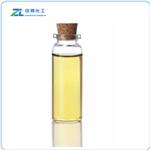Dibenzyl amine (Dibenzylamine), molecular formula C14H15N, molecular weight 197.28, specific density 1.026, fusing point-26 ℃, 300 ℃ of boiling points, specific refractory power 1.574-1.576,143 ℃ of flash-points, water-soluble 0.05G/L (20 ℃). Dibenzyl amine is a colourless oil liquid, is smelly of ammonia, is soluble in ethanol and ether, and is water insoluble. Skin and mucous membranes have a stronger pungency. Dibenzyl amine is an important organic synthesis intermediate. Because dibenzylamine can not derive any carcinogenic nitrosamine and be widely used in the building-up process of medicine such as penicillin, and Linezolid, simultaneously, dibenzylamine can be used for producing the vulcanization accelerator zinc dibenzyldithiocarbamate (ZBEC) of high effect nontoxic and tetra-benzyl thiram disulfide (TBZTD) and can be used for the mensuration of cobalt, iron, cyanate etc.
colorless to light yellow oily liquid with ammonia odor. soluble in ethanol and ether, insoluble in water.
Dibenzylamine is used to prepare rubber accelerator for the vulcanization process and reaction-stoppers. Dibenzylamine type accelerators reduce nitrosamine production in the compounding process. It is also used to produce dibenzyl-nitroso-amine.
ChEBI: Dibenzylamine is an aromatic amine.
Dibenzylamine is obtained by the reaction of benzyl chloride and liquid ammonia in ethanol.
Dibenzylamine is an important organic synthesis intermediate, mainly used to produce efficient and non-toxic vulcanization accelerators tetrabenzylthiuramdisulfide (TBZTD) and zinc dibenzyldithiocarbamate (ZBEC). Synthesize penicillin and curing agent for rubber and plastic curing, and can be used in the detection of cobalt, cyanate, and iron.
Dibenzylamine (DBA) has anticonvulsant effects. It can block NMDA-evoked currents in a concentration and voltage-dependent manner. This conclusion was researched in an audiogenic seizure-susceptible mouse model. It possesses antiproliferative properties and could be of interest for the development of new antitumor drugs.
Dibenzylamine is danger.
H302 (99.32%): Harmful if swallowed [Warning Acute toxicity, oral]
H314 (57.43%): Causes severe skin burns and eye damage [Danger Skin corrosion/irritation]
H315 (42.57%): Causes skin irritation [Warning Skin corrosion/irritation]
H319 (42.57%): Causes serious eye irritation [Warning Serious eye damage/eye irritation]
H412 (32.43%): Harmful to aquatic life with long lasting effects [Hazardous to the aquatic environment, long-term hazard]
The synthesis process of dibenzylamine comprises the following steps: reacting raw materials (benzaldehyde and ammonium hydroxide) for 20-70min at 60-120 DEG C under a hydrogen pressure of 0.5-2.0MPa in the presence of a catalyst, wherein alcohol with 1-4 carbon atoms can be added optionally to serve as an organic solvent and a phase transfer catalyst can be added optionally; by the end of the reaction, cooling, filtering to recover the catalyst, layering the filtrate to obtain a dibenzylamine product; and recycling and reusing excessive ammonium hydroxide.
Purify the amine by distillation in a vacuum. It causes burns to the skin. The dihydrochloride has m 265-266o (from MeOH/HCl), and the tetraphenyl boronate has m 129-133o. [Bradley & Maisey J Chem Soc 247 1954, Hall J Phys Chem 60 63 1956, Donetti & Bellora J Org Chem 37 3352 1972, Beilstein 12 IV 2179.]



